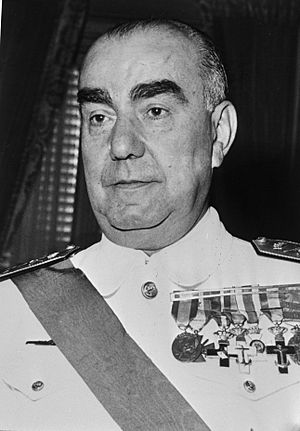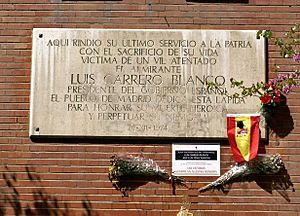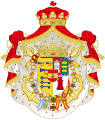Luis Carrero Blanco facts for kids
Quick facts for kids
The Most Excellent Admiral-General
Luis Carrero Blanco
|
|
|---|---|
 |
|
| Prime Minister of Spain | |
| In office 9 June 1973 – 20 December 1973 |
|
| Leader | Francisco Franco |
| Deputy | Torcuato Fernández-Miranda |
| Preceded by | Francisco Franco |
| Succeeded by | Torcuato Fernández-Miranda (acting) |
| Deputy Prime Minister of Spain | |
| In office 22 September 1967 – 9 June 1973 |
|
| Leader | Francisco Franco |
| Preceded by | Agustín Muñoz Grandes |
| Succeeded by | Torcuato Fernández-Miranda |
| Undersecretary of the Presidency | |
| In office 5 May 1941 – 9 June 1973 |
|
| Nominated by | Francisco Franco |
| Preceded by | Valentín Galarza Morante |
| Succeeded by | José María Gamazo |
| Member of the Cortes Españolas | |
| In office 16 March 1943 – 24 March 1946 |
|
| Nominated by | Francisco Franco |
| Personal details | |
| Born |
Luis Carrero Blanco
4 March 1904 Santoña, Spain |
| Died | 20 December 1973 (aged 69) Madrid, Spain |
| Cause of death | Assassination by explosive device |
| Resting place | Mingorrubio Cemetery, El Pardo, Madrid |
| Spouse |
María del Carmen Lozana Abeo
(m. 1946) |
| Children | 5 |
| Signature |  |
| Military service | |
| Allegiance |
|
| Branch/service | Spanish Navy |
| Years of service | 1918–1973 |
| Rank | Admiral |
| Battles/wars |
|
Admiral-General Luis Carrero Blanco (born March 4, 1904 – died December 20, 1973) was a Spanish Navy officer and an important politician. He was a close friend and trusted helper of the leader Francisco Franco. Carrero Blanco served as Spain's Premier and held many other high-ranking jobs in the government led by Franco. He was killed in a car bombing in December 1973.
After finishing naval academy, Carrero Blanco took part in the Rif War. Later, he fought in the Spanish Civil War, supporting the side known as the Rebel faction. He became one of the most important people in the government of Franco's Spain. Throughout his career, he held many top positions. These included being the Undersecretary of the Presidency from 1941 to 1967. He also served as Franco's deputy from 1967 to 1973. He helped write the 1947 Law of Succession to the Headship of the State, which decided how Spain would be led after Franco. Franco chose him to be the next head of government, and Carrero Blanco became Prime Minister in June 1973.
Just a few months after becoming Prime Minister, Carrero Blanco was killed in Madrid. This happened on December 20, 1973, when a bomb exploded near his car. He was on his way back from church. The attack was carried out by a group called Euskadi Ta Askatasuna (ETA), which was a Basque nationalist group.
Contents
Life of Luis Carrero Blanco
Early Years and Education
Luis Carrero Blanco was born on March 4, 1904. His hometown was Santoña, a coastal town in Spain. His father, Camilo Carrero Gutiérrez, was an army officer. His mother was Ángeles Blanco Abascal.
Luis went to school in Santoña. In 1918, when he was 14, he joined the Spanish Naval Academy. This continued his family's tradition of military service. The academy was in San Fernando, Cádiz.
By the age of 18, he became a lieutenant. He served on a large warship called the Alfonso XIII. From 1924 to 1926, he took part in the Rif War. In 1926, he chose to specialize in submarine warfare. He served on submarines like the B-2 and B-5.
In 1929, he married María del Carmen Pichot y Villa. They had five children together.
Role in the Civil War
When the Spanish Civil War began, Carrero Blanco was a naval instructor. He taught about submarine tactics in Madrid. Because he held conservative views, he knew he might be in danger. His brother had already been arrested and killed. His father also died on the day he was arrested.
Like many who supported the Nationalists, he found safety first in the Mexican embassy. Later, he moved to the French embassy. From there, he was able to cross into France. In June 1937, he re-entered Spain on the side of the Nationalists.
Carrero Blanco then served in the Nationalist navy. He was a captain on the destroyer Huesca. Later, he commanded the submarine General Sanjurjo. After the Nationalist side won the war, Generalísimo Franco became the leader of Spain. In August 1939, Carrero Blanco was made Chief of Naval Operations.
His Political Career
In May 1941, Franco appointed Carrero Blanco as the Under-Secretary of the Presidency of the Government. He was 37 years old at the time. Carrero Blanco was very loyal to Franco. He helped Franco make important decisions. For example, after an event in 1942, Carrero advised Franco to remove Ramón Serrano Suñer from his government roles.
Carrero Blanco was promoted to Vice-Admiral in 1963. He became a full Admiral in 1966. From 1967 to 1973, he served as Deputy Prime Minister. By this time, Franco was getting older and often ill. He started to let Carrero Blanco manage the daily running of the government. Carrero Blanco was very good at this. He made sure Franco's policies were followed and directed the different government departments.
In 1969, Juan Carlos of Bourbon was named as Franco's heir to lead the country. Many believed that a strong monarchy, guided by Carrero Blanco, would keep Franco's system going even after Franco was gone. Franco himself said that "all is tied down and well tied down" (está atado y bien atado), meaning his plans for the future were secure.
Carrero Blanco reached the highest point of his political career on June 8, 1973. Franco officially appointed him as Prime Minister. This was part of a plan to separate the roles of head of government and head of state.
His Death
Six months after becoming Prime Minister, Luis Carrero Blanco was killed. This happened on December 20, 1973, in Madrid. Four members of an ETA group carried out a bombing. It happened near San Francisco de Borja Church on Calle de Serrano. Carrero Blanco was returning from his daily church service in his car, a Dodge 3700.
After his death, Carlos Arias Navarro became the new Prime Minister. In his first speech on February 12, 1974, Arias Navarro promised some reforms. These included allowing political groups to form. Even though some people disagreed, this marked the beginning of changes in Spain.
Funeral and Burial
Carrero Blanco's funeral was held the day after his death. It took place at the Basilica of Saint Francis the Great in Madrid. This was one of Franco's last public appearances. Carrero Blanco was buried at Mingorrubio Cemetery in El Pardo. After his death, he was given the special title of "Captain general of the Navy". He was also declared "Duke of Carrero Blanco".
His Writings
Carrero Blanco wrote several books. These books were about the Spanish navy and its history. He also wrote political essays. He sometimes used the pen name Juan de la Cosa.
- Carrero Blanco, Luis (1933) (in fr). Las Baleares durante la Guerra de América en el siglo XVIII. Paris.
- Carrero Blanco, Luis (1941) (in es). España y el mar. Madrid: Editora Nacional.
- Carrero Blanco, Luis (1941) (in es). Cinematica aeronaval. Madrid: Editorial Naval.
- Carrero Blanco, Luis (1943) (in es). Arte naval miltar: El buque de guerra (de la galera al portaaviones).. II. Madrid: Editora Naval.
- Carrero Blanco, Luis (1947) (in es). La guerra aeronaval en el Atlántico y en el Ártico. Madrid: Ediciones Idea.
- Carrero Blanco, Luis (1947) (in es). La guerra aeronaval en el Mediterráneo y en el Pacífico. Madrid: Ediciones Idea.
- Carrero Blanco, Luis (1948) (in es). La victoria del Cristo de Lepanto. Barcelona: Editora Nacional.
- Carrero Blanco, Luis (1971) (in es). Lepanto (1571–1971). Salvat Editorial/Alianza Editorial.
- De la Cosa, Juan (1949) (in es). La gran baza soviética. Comentarios de un español. Valencia: Semana Gráfica.
- De la Cosa, Juan (1950) (in es). Las doctrinas del Komsomol. Comentarios de un español. Valencia: Semana Gráfica.
- De la Cosa, Juan (1950) (in es). España ante el mundo: proceso de un aislamiento. Madrid: Ediciones Idea.
- De la Cosa, Juan (1952) (in es). Gibraltar. Comentarios de un español. Valencia: Semana Gráfica.
- De la Cosa, Juan (1956) (in es). Las modernas torres de Babel. Ediciones Idea.
- De la Cosa, Juan (1973) (in es). Comentarios de un español; Las tribulaciones de don Prudencio; Diplomacia subterránea.. Madrid: Fuerza Nueva.
Images for kids
See also
 In Spanish: Luis Carrero Blanco para niños
In Spanish: Luis Carrero Blanco para niños
- Cassandra case, student prosecuted for posting a series of tweets poking fun at the assassination of Luis Carrero Blanco





